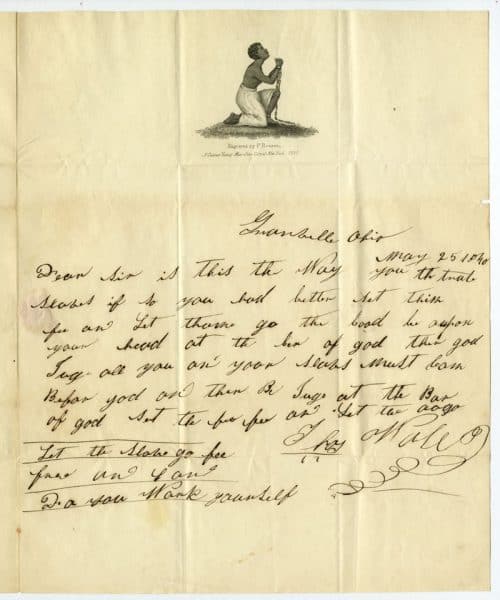LCP Acquires Rare Reason Letterhead
 The Library Company has just purchased at auction a piece of letterhead engraved by Patrick Henry Reason, one of a very small number of commercially successful African American engravers. The stationery pictures the figure of a kneeling female slave and is captioned “Engraved by P. Reason, A Colored Young Man of the City of New York, 1835.” It is an example of letterhead — once common, but today very rare — produced by the American Antislavery Society .
The Library Company has just purchased at auction a piece of letterhead engraved by Patrick Henry Reason, one of a very small number of commercially successful African American engravers. The stationery pictures the figure of a kneeling female slave and is captioned “Engraved by P. Reason, A Colored Young Man of the City of New York, 1835.” It is an example of letterhead — once common, but today very rare — produced by the American Antislavery Society .
The letter the stationery was used for is a largely misspelled antislavery screed addressed to South Carolina slaveholder S. J. Houlk condemning him for brutal cruelty, and ending with the admonition “Let the slave go free an you can do you work yourself.”
Born in New York to free black parents who emigrated from the French West Indies, Reason attended the New York African Free School, where his artistic talents were nurtured. In 1833 he was apprenticed to a New York engraver, and his professional career, which ultimately spanned six decades, took off shortly thereafter. Reason’s first published work was an engraving of his school, appearing as a frontispiece to Charles C. Andrews’ History of the New-York African Free Schools (New York, 1830). Abolitionists were major supporters of the African Free Schools and Reason enjoyed abolitionist patronage early in his career, beginning in 1830s, which enabled him to produce our newest addition to the Afro-Americana collections.
Reason later turned his attention to portraiture, and we hold a half- dozen examples from books and periodicals, including portraits of British abolitionist Granville Sharp, fugitive slaves James Williams and Henry Bibb, Ohio Congressman Benjamin Tappan, c lergyman Robert Adrain, and American statesman George Mifflin Dallas. Reason returned to allegory in 1839, with his antislavery engraving “The Truth Shall Make You Free” appearing as the frontispiece to the abolitionist annual The Liberty Bell (and reproduced on the cover of our 1994 publication The Abolitionist Sisterhood). Reason also has a local family connection; his brother Charles (also an African Free School alumnus and a mathematician) was for several years head of Philadelphia’s Institute for Colored Youth, the most notable academic institution for African Americans in antebellum America.
We’re delighted to have Reason’s early effort added to our collection, especially as we have never before seen one on the market. We remain eager to acquire other examples of his work.

Leave a Reply
Want to join the discussion?Feel free to contribute!